The Seagull Nebula (IC 2177) is a large region of nebulosity located approximately 3,650 light-years away in the constellation Monoceros (the Unicorn), on the border with Canis Major. The nebula includes an H II region, open star clusters, dark dust clouds, and reflection nebulae.
The Seagull Nebula has an apparent size about seven times that of the full Moon. It was named the Seagull because its complex of dust and gas forms a shape reminiscent of that of a seagull in flight.
The nebula is composed of interstellar dust clouds and hydrogen, helium, and other gases that are ionized by the energetic young stars formed within the nebula. The radiation of the new stars causes the surrounding hydrogen gas to glow with a reddish colour in long-exposure images.
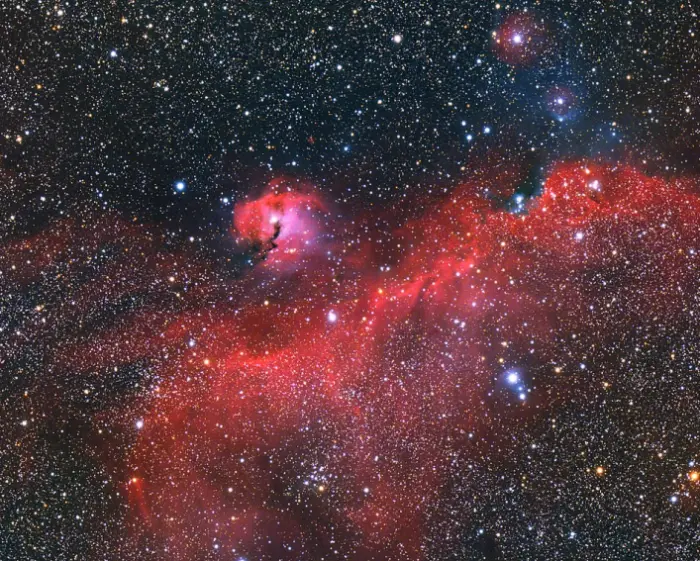
This HII complex on the border of Monoceros and Canis Major covers about 3 degrees of sky, The nebula lies in one of the farthest arms of our Milky Way galaxy and is about 100 light years across. The head of the Seagull is Vdb 93. Also contained within the nebula are the open clusters NGC 2343, NGC 2335, Collinder 465, and Collinder 466. Image credit: Wikimedia Commons/Keesscherer (CC BY-SA 4.0)
The light of the hot blue OB-type stars is also reflected off the tiny dust particles in the nebula’s clouds and it creates patches of reflection nebulosity that contrast with the red emission nebula.
The Seagull Nebula complex is home to dozens of massive OB stars and reflection nebulae, as well as to several embedded young clusters. It is part of the larger star-forming region CMa R1, which is the most prominent feature of the Canis Major OB1 association.
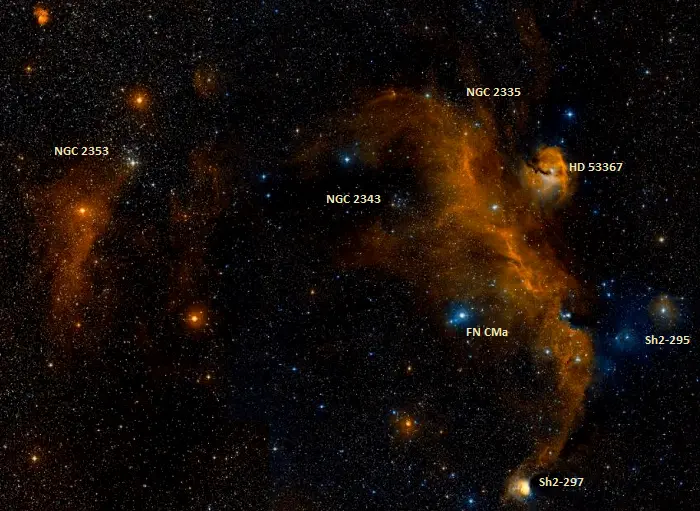
The Seagull Nebula complex, image: Wikisky
The CMa OB1 association may include more than two dozen star clusters that appear in the same line of sight. It is uncertain which ones are physically associated with the group. The open cluster NGC 2353 was once believed to form the core of CMa OB1 but is now believed to be too young to be a member. The same goes for NGC 2343, NGC 2335, and NGC 2323.
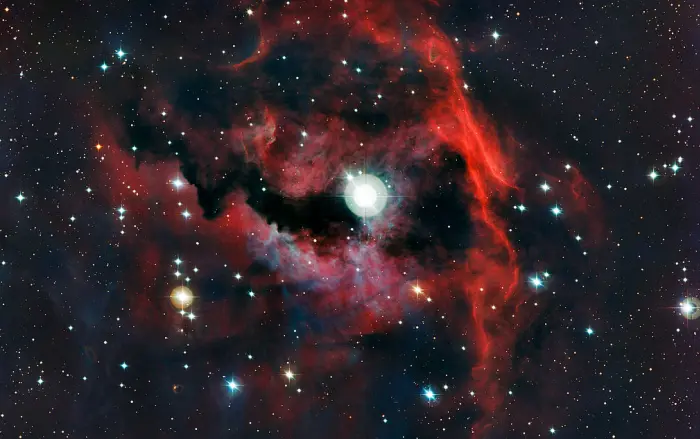
This image from ESO’s La Silla Observatory shows part of a stellar nursery nicknamed the Seagull Nebula. This cloud of gas, known as Sh 2-292, RCW 2 and Gum 1, seems to form the head of the seagull and glows brightly due to the energetic radiation from a very hot young star lurking at its heart. The detailed view was produced by the Wide Field Imager on the MPG/ESO 2.2-metre telescope. Image credit: ESO (CC BY 4.0)
IC 2177 surrounds the star HD 53367, which lies in the Seagull’s head and appears as the Seagull’s eye. The strong ultraviolet radiation from the brilliant young star makes the surrounding nebula glow.
The star is in fact a triple star system whose primary component is a young variable Herbig Ae/Be star – a massive pre-main sequence star – of the spectral type B. The star has a mass more than 12 times that of the Sun and is 11,000 times more luminous than the Sun.
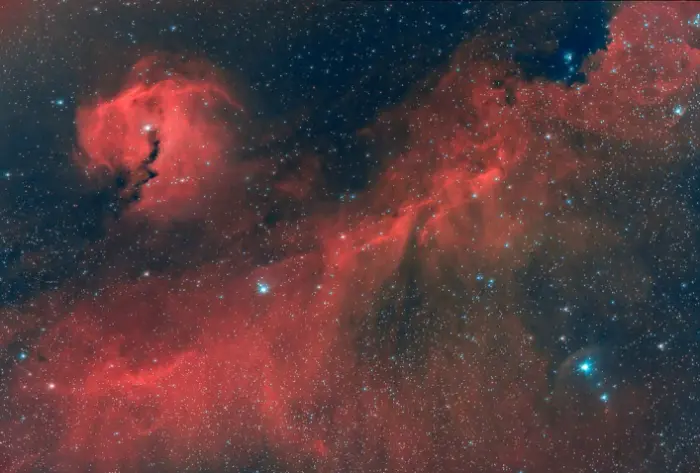
The Seagull Nebula, image credit: Raman Madhira from Ray’s Astrophotography Observatory; postprocessing with PixInsight/Photoshop (CC BY-SA 4.0)
The star has a spectroscopic companion at a separation of only 1.7 astronomical units (Earth-Sun distances). The companion was discovered in 2006. The two stars have an orbital period of 367.7 days. They orbit each other at an angular separation of 2.6 – 2.7 milliarcseconds.
The double star system has a companion, another Herbig Ae/Be star, separated by only 0.6 arcseconds from the main pair. All the components are believed to be members of the CMa OB1 association.
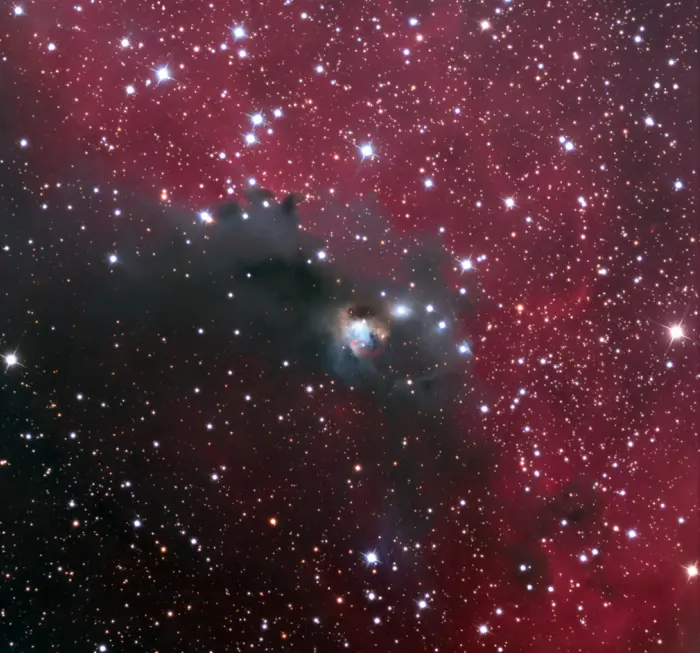
NGC 2327, credit: Adam Block/Mount Lemmon SkyCenter/University of Arizona (CC BY-SA 3.0 US)
The head of the Seagull is a compact cloud that has its own designation in the New General Catalogue, NGC 2327. The nebula is catalogued as Sh2-292 in the second Sharpless catalogue of HII regions (1959). It was the first object catalogued by Australian astronomer Colin Gum in his catalogue of emission nebulae located in the southern sky. It has the designation Gum 1 in the Gum catalogue.
The Seagull’s head is both an emission and reflection nebula. Most of its light is emitted by the gas ionized by newly formed stars, but some of it is also reflected off the stars outside the nebula.
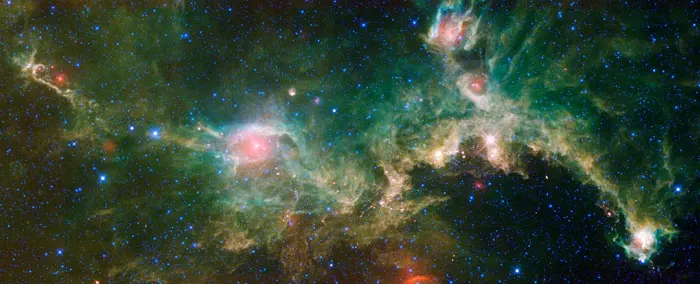
The Seagull Nebula, seen in this infrared mosaic from NASA’s Wide-field Infrared Survey Explorer, or WISE, draws its common name from it resemblance to a gull in flight. But it depends on your point of view. When the image is rotated 180 degrees it bears a passing resemblance to a galloping lizard – or perhaps a dragon or a dinosaur. The image spans an area about seven times as wide as the full Moon, and three times as high (3.55 by 1.37 degrees), straddling the border between the constellations Monoceros and Canis Major (the Big Dog). So you might say this lizard is running with the Big Dog, while the gull is flying from it. All four infrared detectors aboard WISE were used to make this image. Color is representational: blue and cyan represent infrared light at wavelengths of 3.4 and 4.6 microns, which is dominated by light from stars. Green and red represent light at 12 and 22 microns, which is mostly light from warm dust. Credit: NASA/JPL-Caltech/UCLA
The dark dust lanes that give texture to the nebula’s glowing regions are formed of denser material. They conceal some of the brighter portions of the nebula.
The small knot at the tip of the Seagull’s wing is an emission nebula catalogued as Sh2-297, while the smaller nebula near the Seagull has the designation Sh2-295.
Sharpless 2-297 is illuminated by the 8th magnitude star HD 53623, a hot blue giant or bright giant of the spectral type B1II/III. The nebula contains many young stellar objects, including one with a mass of 5.4 solar masses and an extended envelope that weighs between 30 and 40 solar masses.
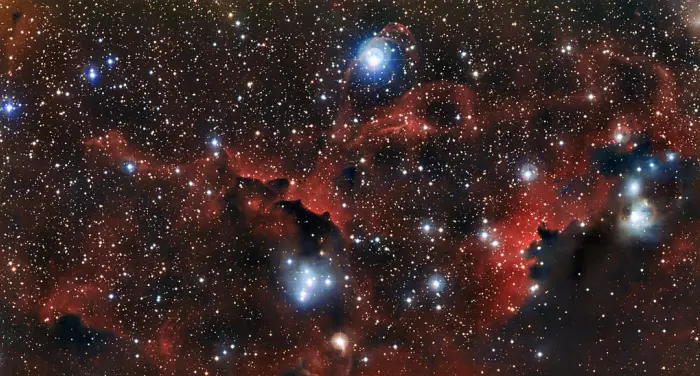
This image shows the intricate structure of part of the Seagull Nebula, known more formally as IC 2177. These wisps of gas and dust are known as Sharpless 2-296 (officially Sh 2-296) and form part of the “wings” of the celestial bird. This region of the sky is a fascinating muddle of intriguing astronomical objects — a mix of dark and glowing red clouds, weaving amongst bright stars. This new view was captured by the Wide Field Imager on the MPG/ESO 2.2-metre telescope at ESO’s La Silla Observatory in Chile. Image: ESO (CC BY 4.0)
The wings of the Seagull are formed by an H II region catalogued as Sharpless 2-296. The wings span 100 light-years across. The star-forming region contains red glowing material and dark lanes of dust. It is the birthplace of new stars. Some of these stars are visible in optical images while others are still shrouded in their parent clouds. They excite the surrounding clouds, causing them to glow. The stars also shape and sculpt the clouds by exerting pressure on them.
The binary star FN Canis Majoris is the brightest star in Sh2-296. It is a massive runaway star that speeds through space and produces a bow shock as its stellar winds interact with the interstellar medium.
The brighter component in the FN CMa system is a B-type star that shines at magnitude 5.69. The star has an estimated mass between 19 and 36 times that of the Sun. The companion is fainter, with an apparent magnitude of 7.04. The system is only 6 million years old.
The Seagull Nebula was discovered by the 19th-century Welsh amateur astronomer and astrophotographer Isaac Roberts. The German-born British astronomer William Herschel had spotted a small bright clump in the nebula in 1785, but the rest of the nebula was discovered photographically by Roberts about a century later.
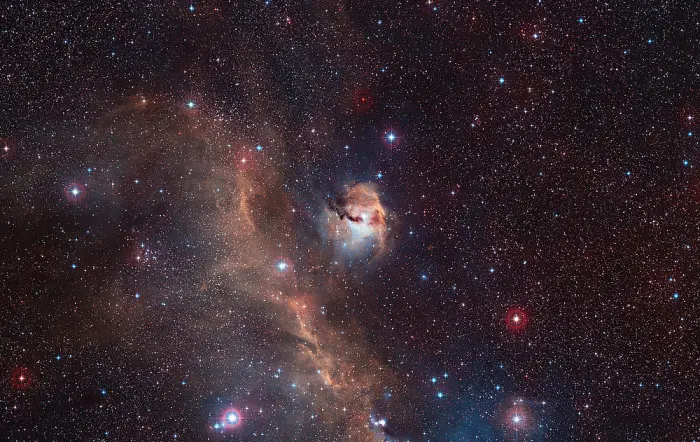
This wide-field view captures the evocative and colourful star formation region of the Seagull Nebula, IC 2177, on the borders of the constellations of Monoceros (the Unicorn) and Canis Major (the Great Dog). This view was created from images forming part of the Digitized Sky Survey 2. Image credit: ESO/Digitized Sky Survey 2 (CC BY 4.0)
Location
The Seagull Nebula lies along the imaginary line extended from Sirius to Procyon. It appears northeast of the magnitude 4.08 orange giant Theta Canis Majoris, the star marking the Great Dog’s nose. Most of the nebula lies in the constellation Monoceros, but a part of one of the Seagull’s wings is located in the neighbouring Canis Major.
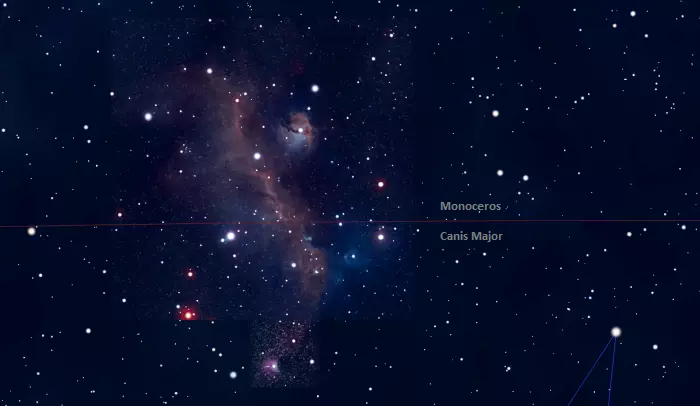
The Seagull Nebula on the border between Canis Major and Monoceros. The asterism known as Pakan’s 3 is visible in the top right part of the image. Credit: Stellarium
Sirius, the brightest star in the night sky, can be found by extending the line formed by the three stars of Orion’s Belt to the southeast. Sirius forms a bright, conspicuous asterism known as the Winter Triangle with Procyon and Betelgeuse. Theta Canis Majoris is the brightest star just northeast of Sirius.
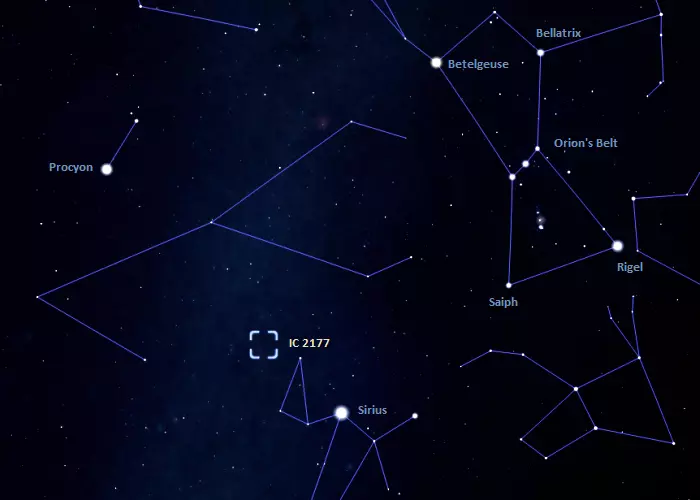
The location of the Seagull Nebula (IC 2177), image: Stellarium
The Seagull Nebula lies in the same area as the smaller Thor’s Helmet Nebula (NGC 2359), an emission nebula 11,960 light-years away in Canis Major. The two nebulae appear in the same wide field of view in small telescopes. Thor’s Helmet is illuminated by the Wolf-Rayet star WR7, an exceptionally hot star that will soon meet its end in a brilliant supernova.
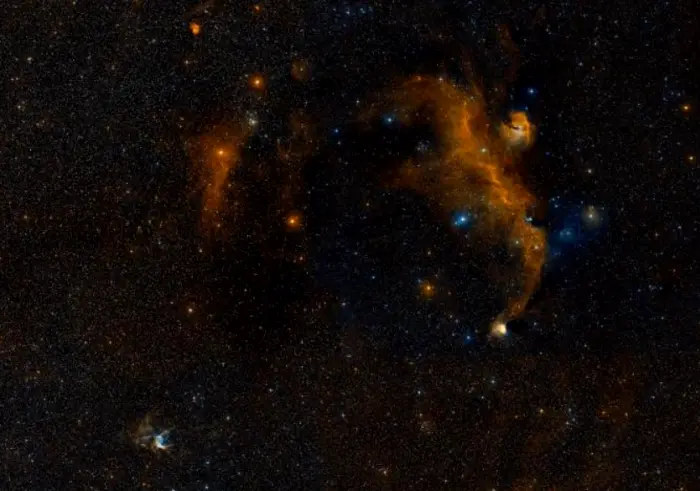
The Seagull Nebula and Thor’s Helmet Nebula (bottom left), image: Wikisky
The best time of the year to observe the deep sky objects in Monoceros and Canis Major is during the month of February, when these constellations are high above the horizon in the evening.
Seagull Nebula – IC 2177
| Constellation | Monoceros, Canis Major |
| Right ascension | 07h 04m 25s |
| Declination | −10° 27′ 18″ |
| Apparent magnitude | 15.23 |
| Distance | 3,650 light-years (1,120 parsecs) |
| Names and designations | Seagull Nebula, IC 2177, Gum 1, Sh2-292, LBN 1027, PKS 0702-103, PKS J0704-1027, VDB 93, RCW 2, RRF 2486 |